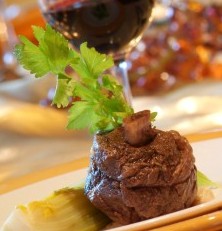The weather took a right turn and thermometer began to drop this week, so a young man’s culinary fancy turns to braising.
 This is one of our favorite recipes for several reasons. First, by using a cut of meat not normally used, you promote economic and environmental sustainability by making use of all the beef. The concept goes back to my practical European training where chefs “use everything from an animal.” The short rib of beef is cut from the beef back ribs consisting of seven ribs from the rib section, including the meat between the rib bones.
This is one of our favorite recipes for several reasons. First, by using a cut of meat not normally used, you promote economic and environmental sustainability by making use of all the beef. The concept goes back to my practical European training where chefs “use everything from an animal.” The short rib of beef is cut from the beef back ribs consisting of seven ribs from the rib section, including the meat between the rib bones.
Second, this is a perfect dish for those cold weather months – curl up around a fire, sip a glass of red wine, and savor succulent braised meat so tender it literally falls off the bone. Lastly, I playfully like to think this recipe playfully illustrates that the concept of “surf & turf” can go beyond lobster and filet. The saltiness of the anchovy rounds out the rich beef flavors and takes this simple dish from ordinary to sublime.
For the Braised Beef Short Ribs
2 pounds natural beef short ribs, cut 1½-inch thick and trimmed,
kosher salt and cracked black pepper, to taste
vegetable oil, as needed
1 medium onion, peeled and roughly chopped
1 carrot, peeled and roughly chopped
2 ribs celery, roughly chopped
1 large tomato, roughly chopped
3 cloves garlic, peeled, roughly chopped
1 tablespoon whole black peppercorns
1 bay leaf
4 sprigs fresh thyme
½ cup port wine
1 cup Cabernet Sauvignon wine or other (substitute a relative non-fruity, dry red wine)
2-3 cups chicken stock, veal stock, beef stock or water
1-2 oil-packed anchovy fillets, rinsed
To Prepare the Short Ribs: Preheat oven to 350ºF. Season ribs with salt and pepper and set aside.
Place a large ovenproof braising pan over medium-high heat. Add enough oil to coat the bottom of the pan. Add the ribs and brown all sides. Remove meat and most of the fat from the pan. Add the onion, carrot, celery, tomato and garlic to the pan. Sauté the vegetables until they begin to brown. Add the peppercorns, bay leaf and thyme. Add both wines to the pan and reduce the liquid until half of the volume remains. Return the ribs to the pan and add enough stock to just cover the meat. Bring stock to a boil and then reduce to a simmer.
Cover and place pan in oven. Braise 1 to 2 hours (depending on the size of the ribs) or until meat is tender and just begins to fall off the bone.
Remove meat from pan and keep warm. Strain the cooking liquid into a saucepan. Simmer until liquid is reduced by half. Add the anchovies. Using a blender, purée until smooth. Taste and adjust seasoning. Keep warm.
To Serve: Serve with sautéed greens and caramelized root vegetables or a soft polenta and wild mushrooms.
Advance Preparation: The beef can be made several days ahead of serving. I actually feel the flavors are better and more complex if the beef is allowed to cool and then reheated in the sauce and served the following day.
Substitutions and Options: Any leftover meat can be shredded and made into a luxurious ravioli filling or pasta sauce.
Look for naturally raises, 100% pasture-raised, locally sourced beef. Trust me, you taste buds and your significant other will thank you.
If you choose not to make your own stock, purchase an organic, natural stock with no added salt.
Wine Notes: The wine reduction in the braising liquid (later turned into the sauce for the dish) ties the food to the wine. The salty flavor of the anchovies will cut through both the fattiness of the ribs and balance the sweetness of the fruit in a young Cabernet Sauvignon or Merlot.
Recommended: Chateau Ste. Michelle, Indian Wells Cabernet Sauvignon, Columbia Valley, Washington, a balanced, food friendly Cabernet that is drinkable right now and usually retails for under $20. Or if the budget allows, Walla Walla Vintners, Cabernet Sauvignon, Walla Walla Valley, Washington or look for the ’05 or ’06 Leonetti, Merlot, Columbia Valley, Washington, two of the best vintages in Washington state history for Merlot and Cab.
Makes 4 entrée servings